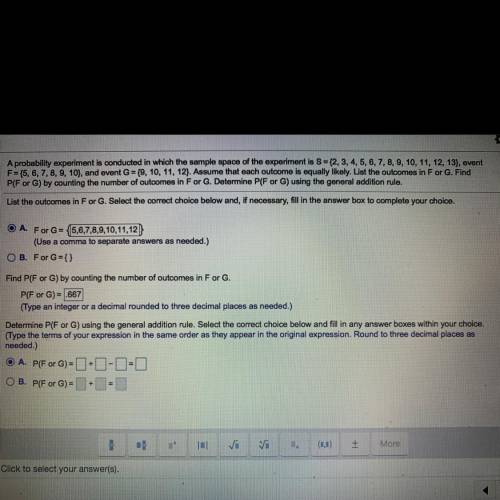A probability experiment is conducted in which the sample space of the experiment is
S = {2, 3...

Mathematics, 19.05.2020 03:13 idklol81
A probability experiment is conducted in which the sample space of the experiment is
S = {2, 3, 4, 5, 6, 7, 8, 9, 10, 11, 12, 13), event F = {5, 6, 7, 8, 9, 10), and event G = {9, 10, 11, 12). Assume that
each outcome is equally likely. List the outcomes in For G. Find P(F or G) by counting the number of outcomes in
For G. Determine P(F or G) using the general addition rule.


Answers: 1


Other questions on the subject: Mathematics

Mathematics, 21.06.2019 19:00, abraham1366
Which values of p and q result in an equation with exactly one solution? px-43=-42x+q choose all answers that apply: a) p=-43 and q=-43 b) p=42 and q=43 c) p=43 and q=−42 d) p=42 and q=42
Answers: 1


Mathematics, 21.06.2019 22:00, Ezonthekid
What is the value of the discriminant of the quadratic equation -2x = -8x + 8 and what does its value mean about thenumber of real number solutions the equation has?
Answers: 3

Mathematics, 21.06.2019 23:00, dianereyes7475
The angles in a triangle are represented by 5x, 8x, and 2x+9. what is the value of ? a.10.8 b.11.4 c.9.7 d.7.2
Answers: 2
You know the right answer?
Questions in other subjects:


History, 18.08.2021 21:10





Mathematics, 18.08.2021 21:10

History, 18.08.2021 21:10

English, 18.08.2021 21:10

Mathematics, 18.08.2021 21:10




